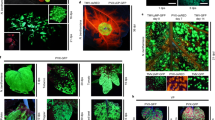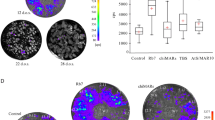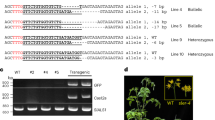Abstract
Desirable new phenotypes created by the introduction of foreign DNA into plants are frequently unstable following propagation, leading to a loss of the newly acquired traits. This genetic instability is due not to deletion or mutation of the introduced DNA but rather to the inactivation of the transgene. In this review, we discuss the mechanisms that might be responsible for transgene inactivation and examine means of stabilizing gene expression in transgenic plants.
This is a preview of subscription content, access via your institution
Access options
Subscribe to this journal
Receive 12 print issues and online access
$209.00 per year
only $17.42 per issue
Buy this article
- Purchase on Springer Link
- Instant access to full article PDF
Prices may be subject to local taxes which are calculated during checkout
Similar content being viewed by others
References
Stockhaus, J., Eckes, P., Blau, A., Schell, J. and Willmitzer, L. 1987. Organ-specific and dosage-dependent expression of a leaf/stem specific gene from potato after tagging and transfer into potato and tobacco plants. Nucl. Acids Res. 15: 3479–3491.
Hobbs, S.L.A., Kpodar, P. and Delong, C.M.O. 1990. The effect of T-DNA copy number, position and methylation on reporter gene expression in tobacco transformants. Plant Mol. Biol. 15: 851–864.
Jones, J.D., Dunsmuir, P. and Bedbrook, J. 1985. High level expression of introduced chaemeric genes in regenerated transformed plants. EMBO J. 4: 2411–2418.
Eckes, P., Schell, J. and Willmitzer, L. 1985. Organ-specific expression of three leaf/stem specific cDNAs from potato is regulated by light and correlated with chloroplast development. Molec. Gen. Genet. 199: 216–221.
Nagy, F., Morelli, G., Fraley, R.T., Rogers, S.G. and Chua, N.-H. 1985. Photoregulated expression of a pea rbcS gene in leaves of transgenic plants. EMBO J. 4: 3063–3068.
Pröls, F. and Meyer, P. 1992. The methylation patterns of chromosomal integration regions influence gene activity of transferred DNA in Petunia hybrida. Plant J. 2: 465–475.
Meyer, P., Linn, F., Heidmann, I., Meyer, H., Niedenhof, I. and Saedler, H. 1992. Endogenous and environmental factors influence 35S promoter methylation of a maize AI gene construct in transgenic petunia and its colour phenotype. Mol. Gen. Genet. 231: 345–352.
Ottaviani, M.-P., Smits, T. and Häenisch ten Cate, C.H. 1993. Differential methylation and expression of the β-glucuronidase and neomycin phosphotransferase genes in transgenic potato cv Bintje. Plant Sci. 88: 73–81.
Register, J.C., Peterson, D.J., Bell, P.J., Bullock, W.P., Evans, I.J., Frame, B., Greenland, A.J., Higgs, N.S., Jepson, I., Jiao, S., Lewnau, C.J., Sillick, J.M. and Wilson, H.M. 1994. Structure and function of selectable and nonselectable transgenes in maize following introduction by particle bombardment. Plant Mol. Biol. In press.
Deroles, S.C. and Gardner, R.C. 1988a. Expression and inheritance of kanamycin resistance in a large number of transgenic petunias generated by Agrobacterium-mediated transformation. Plant Molec. Biol. 11: 355–364.
Deroles, S.C. and Gardner, R.C. 1988b. Analysis of the T-DNA structure in a large number of transgenic petunias generated by Agrobacterium-mediated transformation. Plant Molec. Biol. 11: 365–377.
Scheid, O.M., Paszkowski, J. and Potrykus, I. 1991. Reversible inactivation of a transgene in Arabidopsis thaliana. Mol. Gen. Genet. 228: 104–112.
Matzke, M.A., Primig, M., Trnovsky, J. and Matzke, A.J.M. 1989. Reversible methylation and inactivation of marker genes in sequentially transformed tobacco plants. EMBO J. 8: 643–649.
Battraw, M. and Hall, T.C. 1992. Expression of a chimeric neomycin phospho-transferase II gene in first and second generation transgenic rice plants. Plant Sci. 86: 191–202.
Gelvin, S.B., Karcher, S.J. and DiRita, V.J. 1983. Methylation of the T-DNA in Agrobacterium tumefaciens and in several crown gall tumors. Nucl. Acids Res. 11: 159–174.
Hepburn, A.G., Clarke, L.E., Pearson, L. and White, J. 1983. The role of cytosine methylation in the control of nopaline synthase gene expression in a plant tumor. J. Mol. Appl. Genet. 2: 315–329.
Amasino, R.M., Powell, A.L.T. and Gordon, M.P. 1984. Changes in T-DNA methylation and expression are associated with phenotypic variation and plant regeneration in a crown gall tumor line. Mol. Gen. Genet. 197: 437–446.
Peerbolte, R., Leenhouts, K., Hooykaas-van Slogteren, G.M.S., Wullems, G.J. and Schilperoort, R.A. 1986. Clones from a shooty tobacco crown gall tumor II: irregular T-DNA structures and organization, T-DNA methylation and conditional expression of opine genes. Plant Mol. Biol. 7: 285–299.
John, M.C. and Amasino, R.M. 1989. Extensive changes in DNA methylation patterns accompany activation of a silent T-DNA ipt gene in Agrobacteriun-tumefaciens-transformed plant cells. Mol. Cell. Biol. 9: 4298–4303.
Klaas, M., John, M.J., Crowell, D.N. and Amasino, R.M. 1989. Rapid induction of genomic demethylation and T-DNA gene expression in plant cells by 5-azacytidine derivatives. Plant Mol. Biol. 12: 413–423.
Meyer, P., Heidmann, I., Forkmann, G. and Saedler, H. 1987. A new petunia flower colour generated by transformation of a mutant with a maize gene. Nature 330: 677–678.
Linn, F., Heidmann, I., Saedler, H. and Meyer, P. 1990. Epigenetic changes in the expression of the maize Al gene in Petunia hybrida: role of numbers of integrated gene copies and state of methylation. Mol. Gen. Genet. 222: 329–336.
Meyer, P. and Heidmann, I. 1994. Epigenetic variants of a transgenic petunia line show hypermethylation in transgene DNA: an indication for specific recognition of foreign DNA in transgenic plants. Mol. Gen. Genet. 243: 390–399.
Walter, C., Broer, I., Hillemann, D. and Phler, A. 1992. High frequency, heat treatment-induced inactivation of the phosphinothricin resistance gene in transgenic single cell suspension cultures of Medicago sativa. Mol. Gen. Genet. 235: 189–196.
Matzke, M.A. and Matzke, A.J.M. 1990. Gene interactions and epigenetic variation in transgenic plants. Devel. Genet. 11: 214–223.
Matzke, M.A. and Matzke, A.J.M. 1991. Differential inactivation and methylation of a transgene in plants by two suppressor loci containing homologous sequences. Plant Mol. Biol. 16: 821–830.
Matzke, M.A., Neuhuber, F. and Matzke, A.J.M. 1993. A variety of epistatic interactions can occur between partially homologous transgene loci brought together by sexual crossing. Mol. Gen. Genet. 236: 379–389.
Vaucheret, H. 1993. Identification of a general silencer for 19S and 35S promoters in a transgenic tobacco plant: 90bp of homology in the promoter sequence are sufficient for trans-inactivation. C. R. Acad. Sci. Paris, Science de la vie/Life Sciences 316: 1471–1483.
Meyer, P., Heidmann, I. and Niedenhof, I. 1993. Differences in DNA-methylation are associated with a paramutation phenomenon in transgenic petunia. Plant J. 4: 89–100.
McElroy, D. and Brettell, R.I.S. 1994. Foreign gene expression in transgenic cereals. TIBTECH 12: 62–68.
Schuh, W., Nelson, M.R., Bigelow, D.M., Orum, T., v Orth, C.E., Lynch, P.T., Eyles, P.S., Blackball, N.W., Jones, J., Cocking, E.C. and Davey, M.R. 1993. The phenotype characterisation of R2 generation transgenic rice plants under field conditions. Plant Sci. 89: 69–79.
Assaad, F.F., Tucker, K.L. and Signer, E.R. 1993. Epigenetic repeat-induced silencing (RIGS) in Arabidopsis. Plant Mol. Biol. 22: 1067–1085.
Selker, E.U. 1990. Premeiotic instability of repeated sequences in Neurospora crassa. Ann. Rev. Genet. 24: 579–613.
Rhounim, L., Rossignol, J.L. and Faugeron, G. 1992. Epimutation of repeated genes in Ascobolus immersus. EMBO J. 11: 4451–4457.
Renckens, S., de Greve, H., van Montague, M. and Hernalsteens, J.-P. 1992. Petunia plants escape from negative selection against a transgene by silencing foreign DNA via methylation. Mol. Gen. Genet. 233: 53–64.
Hobbs, S.L.A., Warkentin, T.D. and DeLong, C.M.O. 1993. Transgene copy number can be postively or negatively associated with transgene expression. Plant Mol. Biol. 21: 17–26.
Brink, R.A. 1973. Paramutation. Ann. Rev. Genet. 7: 129–152.
Harrison, B.J. and Carpenter, R. 1973. A comparison of the instabilities at the Nivea and Pallida loci in Antirrhinum majus. Heredity 31: 309–323.
Patterson, G.I., Thorpe, C.J. and Chandler, V.L. 1993. Paramutation, an allelic interaction, is associated with a stable and heritable reduction of transcription of the maize b regulatory gene. Genetics 135: 881–894.
Paro, R. 1990. Imprinting a determined state into the chromatin of Drosophila. Trends Genet. 6: 416–421.
Paro, R. 1993. Mechanisms of heritable gene repression during development of Drosophila. Curr. Opin. Cell Biol. 5: 999–1005.
Laurenson, P. and Rine, J. 1992. Silencers, silencing and heritable transcriptional states. Microbiol. Rev. 56: 543–560.
Mol, J.N.M., Stuitje, A.R. and van der Krol, A. 1989. Genetic manipulation of floral pigmentation genes. Plant Mol. Biol. 13: 287–294.
Napoli, C., Lemieux, C. and Jorgensen, R. 1990. Introduction of a chimeric chalcone synthase gene into petunia results in reversible co-suppression of homologous genes in trans. Plant Cell 2: 279–289.
van der Krol, A.R., Mur, L.A., Beld, M., Mol, J.N.M. and Stuitje, A.R. 1990. Flavonoid genes in petunia: addition of a limited number of gene copies may lead to a suppression of gene expression. Plant Cell 2: 291–299.
Mol, J., van Blokland, R. and Kooter, J. 1991. More about co-suppression. TIBTECH 9: 182–183.
Kooter, J.M. and Mol, J.N.M. 1993. Trans-inactivation of gene expression in plants. Curr. Opin. Biotechnol. 4: 166–171.
Flavell, R.B. 1994. Inactivation of gene expression in plants as a consequence of specific sequence duplication. Proc. Natl. Acad. Sci. USA 91: 3490–3496.
Smith, C.J.S., Watson, C.F., Bird, C.R., Ray, J., Schuch, W. and Grierson, D. 1990. Expression of a truncated tomato polygalacturonase gene inhibits expression of the endogenous gene in transgenic plants. Mol. Gen. Genet. 224: 477–481.
Neuhaus, J.-M., Ahl-Goy, P., Hinz, U., Flores, S. and Meins, F.J. 1991. High level expression of a tobacco chitinase gene in Nicotiana sylvestris. Susceptibility of transgenic plants to Cercospora nicotianae infection. Plant Mol. Biol. 16: 141–15.
de Carvalho, F., Gheysen, G., Kushnir, S., van Montagu, M., Inzé, D. and Castresana, C. 1992. Suppression of β-1,3-glucanase transgene expression in homozygous plants. EMBO J. 11: 2595–2602.
Hart, C.M., Fischer, B., Neuhaus, J.-M. and Meins, F.J. 1992. Regulated inactivation of homologous gene expression in transgenic Nicotiana sylvestris plants containing a defense-related tobacco chitinase gene. Mol. Gen. Genet. 235: 179–188.
Seymour, G.B., Fray, R.G., Hill, P. and Tucker, G.A. 1993. Down-regulation of two non-homologous endogenous tomato genes with a single chimaeric sense gene construct. Plant Mol. Biol. 23: 1–9.
Fray, R.G. and Grierson, D. 1993. Identification and genetic analysis of normal and mutant phytoene synthase genes of tomato by sequencing, complementation and co-suppression. Plant Mol. Biol. 22: 589–602.
Goring, D.R., Thomson, L. and Rothstein, S.J. 1991. Transformation of a partial nopaline synthase gene into tobacco suppresses the expression of a resident wild-type gene. Proc. Natl. Acad. Sci. USA 88: 1770–1774.
Lagrimini, L.M., Bedford, S. and Rothstein, S. 1990. Peroxidase-induced wilting in transgenic tobacco plants. Plant Cell 2: 7–18.
Bollmann, J., Carpenter, R. and Coen, E.S. 1991. Allelic interactions at the nivea locus of Antirrhinum. Plant Cell 3: 1327–1336.
Lindbo, J.A., Silva-Rosales, L., Proebsting, W.M. and Dougherty, W.G. 1993. Induction of a highly specific antiviral state in transgenic plants: implications for regulation of gene expression and virus resistance. Plant Cell 5: 1749–1769.
Dehio, C. and Schell, J. 1994. Identification of plant genetic loci involved in a posttranscriptional mechanism for meiotically reversible transgene silencing. Proc. Natl. Acad. Sci. USA 91: 5538–5542.
Salinas, J., Matassi, G., Montero, L.M. and Bernadi, G. 1988. Compositional compartmentalization and compositional patterns in the nuclear genomes of plants. Nucl. Acids Res. 16: 4269–4285.
Matassi, G., Montero, L.M., Salinas, J. and Bernadi, G. 1989. The isochore organization and the compositional distribution of homologous coding sequences in the nuclear genome of plants. Nuci. Acids Res. 17: 5273–5290.
Wassenegger, M., Heimes, S., Riedel, L. and Sanger, H. 1994. RNA-directed de novo methylation of genomic sequences in plants. Cell 76: 567–576.
Jorgensen, R. 1992. Silencing of plant genes by homologous transgenes. AgBiotech. News Inform. 4: 265N–273.
Stief, A., Winter, D.M., Strätling, W.H. and Sippel, A.E. 1989. A nuclear DNA attachment element mediates elevated and position-independent gene activity. Nature 341: 343–345.
Breyne, P., van Montagu, M., Depicker, A. and Gheysen, G. 1992. Characterization of a plant scaffold attachment region in a DNA fragment that normalizes transgene expression in tobacco. Plant Cell 4: 463–471.
Allen, G.C., Hall, G.E.J., Childs, L.C., Weissinger, A.K., Spiker, S. and Thompson, W.F. 1993. Scaffold attachment regions increase reporter gene expression in stably transformed plant cells. Plant Cell 5: 603–613.
Mlyn v, L., Loonen, A., Heldens, J., Jansen, R.C., Keizer, P., Stiekema, W.J. and Nap, J.-P. 1994. Reduced position effect in mature transgenic plants conferred by the chicken lysozyme matrix-associated region. Plant Cell 6: 417–42.
Laemmli, U.K., Kas, E., Poljak, L. and Adachi, Y. 1992. Scaffold associated regions: cis-acting determinants of chromatin structural loops and functional domains. Curr. Opin. Gen. Devel. 2: 275–285.
Lichtenstein, M., Keini, G., Cedar, H. and Bergman, Y. 1994. B cell-specific demethylation: a novel role for the intronic k chain enhancer sequence. Cell 76: 913–923.
Yoder, J.I. and Goldsbrough, A.P. 1994. Transformation systems for generating marker-free transgenic plants. Bio/Technol. 12: 263–267.
Author information
Authors and Affiliations
Corresponding author
Rights and permissions
About this article
Cite this article
Finnegan, J., McElroy, D. Transgene Inactivation: Plants Fight Back!. Nat Biotechnol 12, 883–888 (1994). https://doi.org/10.1038/nbt0994-883
Issue Date:
DOI: https://doi.org/10.1038/nbt0994-883
This article is cited by
-
Validation of reliable safe harbor locus for efficient porcine transgenesis
Functional & Integrative Genomics (2022)
-
First genome edited poinsettias: targeted mutagenesis of flavonoid 3′-hydroxylase using CRISPR/Cas9 results in a colour shift
Plant Cell, Tissue and Organ Culture (PCTOC) (2021)
-
Expression of hybrid fusion protein (Cry1Ac::ASAL) in transgenic rice plants imparts resistance against multiple insect pests
Scientific Reports (2018)
-
Transgenerational stress-adaption: an opportunity for ecological epigenetics
Plant Cell Reports (2018)
-
Spatiotemporal activities of Douglas-fir BiP Pro1 promoter in transgenic potato
Planta (2018)



